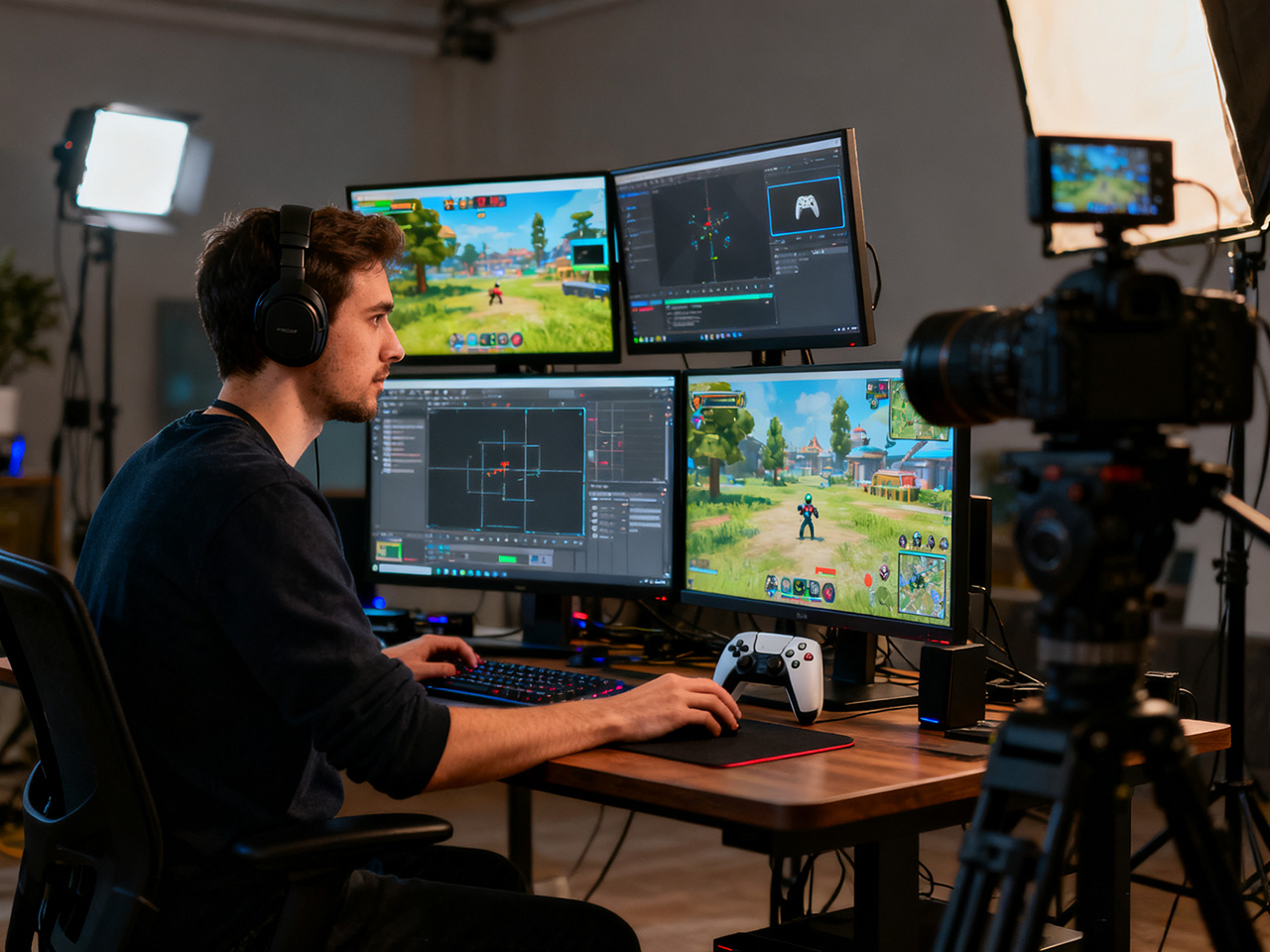
Behind the Scenes: How Major Game Developers are Shaping the Future of Gaming
In the dynamic world of gaming, major developers are constantly pushing the boundaries to redefine the gaming experience. From groundbreaking graphics to immersive storytelling, the industry is on a trajectory towards a future that promises unprecedented innovation. This article explores how key players in the gaming industry are leveraging technology, creativity, and consumer feedback to shape the future of gaming.
Embracing Cutting-Edge Technology
Technology has always been at the core of video game development, and today, it is more integral than ever. Major developers are investing heavily in new technologies to create more realistic and engaging experiences. One of the most significant advancements is the use of real-time ray tracing, which enhances lighting effects to produce stunningly realistic visuals. Companies like NVIDIA and AMD are leading this charge by providing powerful graphics processing units that make these effects possible.
Another technological frontier is the integration of 5G technology. With faster internet speeds and reduced latency, 5G is set to revolutionize gaming by enabling seamless streaming experiences and real-time multiplayer interactions. This technology allows developers to create more complex and expansive worlds, enhancing the player’s immersion and engagement.
Virtual Reality and Augmented Reality
Virtual Reality (VR) and Augmented Reality (AR) are not new concepts, but their application in gaming continues to evolve. Developers are striving to create more intuitive and lifelike VR experiences, as seen in games like “Half-Life: Alyx” and “Beat Saber.” These games demonstrate the potential of VR to offer players a sense of presence within the game world, a key element that enhances immersion.

AR, on the other hand, blends digital elements with the real world, providing a unique interactive experience. Games like “Pokémon GO” have shown how AR can captivate a global audience by encouraging players to explore their physical environment. With the advancement of AR technology, developers are exploring new ways to integrate it into traditional gaming frameworks, promising an exciting future for gamers.
Innovative Storytelling and Narrative Techniques
Beyond technology, storytelling remains a crucial component of game development. Major developers are constantly exploring new narrative techniques to create more compelling stories. The use of motion capture technology has allowed for more expressive character performances, as seen in titles like “The Last of Us Part II.” This technology captures subtle facial expressions and body language, adding depth to character interactions and emotional moments.
Moreover, interactive storytelling has taken center stage, with games like “Detroit: Become Human” offering players choices that significantly impact the narrative. This approach not only increases replayability but also immerses players more deeply into the story. As developers continue to experiment with branching narratives and player agency, the line between games and interactive films continues to blur.
Community Engagement and Feedback
In today’s gaming landscape, community engagement is more important than ever. Major developers are increasingly relying on player feedback to shape their games. Platforms like Steam and Reddit provide valuable insights into player preferences and expectations. By actively listening to their communities, developers can make informed decisions about game updates, features, and future projects.

Community-driven content, such as mods and custom levels, also plays a significant role in maintaining a game’s longevity. Games like “The Elder Scrolls V: Skyrim” have thrived due to the active modding community, which continuously adds new content and enhances the game’s replayability. By supporting and encouraging community creativity, developers can keep their games fresh and relevant for years.
The Rise of Indie Developers
While major developers dominate the industry, indie developers are gaining traction with innovative and unique games. These smaller studios often take risks that larger companies might avoid, leading to creative and groundbreaking experiences. Games like “Hades” and “Celeste” have received critical acclaim for their fresh gameplay mechanics and compelling narratives.
Indie developers often rely on digital distribution platforms, such as GOG.com, to reach a global audience. This accessibility, combined with a lower barrier to entry, allows indie games to flourish in a market traditionally dominated by big-budget titles. As a result, the diversity of gaming experiences continues to expand, offering players a wider range of genres and styles to explore.
Future Trends and Predictions
As gaming technology and player expectations evolve, several trends are likely to shape the future of gaming. One significant trend is the shift towards cloud gaming. Services like Google Stadia and Microsoft’s Xbox Cloud Gaming are paving the way for a future where high-quality games can be streamed on any device, eliminating the need for expensive hardware.

Another trend is the increasing integration of artificial intelligence (AI) in game development. AI-driven procedural generation can create vast, dynamic worlds, while AI-powered NPCs offer more realistic and adaptive interactions. As AI technology advances, it is poised to revolutionize game design and player experiences.
Takeaways
The future of gaming is bright, with major developers at the forefront of innovation. By embracing new technologies, refining storytelling techniques, engaging with communities, and supporting indie developers, the gaming industry is poised for unprecedented growth and creativity. As players, we can look forward to a future where games continue to captivate, challenge, and inspire us in ways we never imagined.
The Role of Esports in Shaping Gaming
Another pivotal element in the evolution of gaming is the explosive growth of esports. Competitive gaming has transformed from a niche interest into a global phenomenon, drawing in millions of viewers and offering substantial prize pools. Major game developers are increasingly designing their games with esports in mind, ensuring that they are balanced and provide a competitive environment.
Games like “League of Legends,” “Dota 2,” and “Counter-Strike: Global Offensive” have established themselves as staples in the esports arena. Developers like Riot Games and Valve continuously update these games to maintain fair play and competitive integrity, ensuring that they remain popular with both players and viewers. The success of these games in esports not only boosts their longevity but also enhances their cultural impact.
Moreover, the rise of esports has led to the creation of professional gaming leagues and tournaments, similar to traditional sports. These events draw in substantial viewership, often rivaling mainstream sports in terms of audience size. This growth in esports is pushing developers to consider new ways to integrate competitive elements into their games, further blurring the lines between gaming and sports entertainment.

Social Connectivity and Multiplayer Experiences
Social connectivity is another driving force behind the future of gaming. With the rise of multiplayer games, developers are focusing on creating experiences that foster social interaction and cooperation. Games like “Fortnite” and “Among Us” have demonstrated the power of social gaming, bringing players together from around the world to collaborate and compete.
These games often feature cross-platform play, allowing friends to connect regardless of their preferred gaming device. The integration of social media and streaming platforms also enhances the social aspect of gaming, enabling players to share their experiences and build communities. As developers continue to innovate in this area, the social fabric of gaming will likely become even more integral to the experience.
Diversity and Inclusion in Gaming
As the gaming audience grows increasingly diverse, developers are recognizing the importance of representation and inclusion. Major studios are striving to create games that reflect a wide range of cultures, identities, and experiences. This commitment to diversity is evident in games like “The Sims” series, which allows players to create characters and stories that align with their own identities.
Furthermore, developers are making strides to ensure accessibility for players with disabilities. Initiatives like customizable controls, colorblind modes, and audio descriptions are becoming more common, allowing more players to enjoy games without barriers. By prioritizing diversity and accessibility, developers not only broaden their audience but also enrich the gaming experience for everyone.

Environmental Sustainability in Game Development
As awareness of environmental issues grows, game developers are exploring ways to make their production processes more sustainable. This includes optimizing energy consumption during game development and considering the environmental impact of physical game packaging. Digital distribution has already reduced the need for physical media, but developers are also looking into greener server technologies and sustainable marketing practices.
Some developers are even incorporating environmental themes into their games, raising awareness about sustainability issues. Games like “Eco” and “Beyond Blue” challenge players to consider the impact of their actions on the virtual environment, paralleling real-world ecological concerns. By taking steps towards sustainability, developers can positively influence both their industry and their audience.
Conclusion: A Future Full of Possibilities
The future of gaming is a tapestry of technological innovation, creative storytelling, and community engagement. Major developers are at the helm, steering the industry towards a future where games are more immersive, inclusive, and impactful than ever before. As players, we are on the cusp of experiencing gaming in ways that transcend mere entertainment, offering new avenues for connection, expression, and exploration.
With advancements in technology, a commitment to diversity, and an eye towards sustainability, the gaming industry is poised to continue its upward trajectory. As we look forward to what lies ahead, one thing is certain: the future of gaming holds endless possibilities, and it is a journey we are all invited to embark upon.






